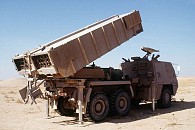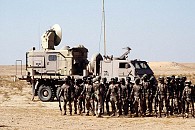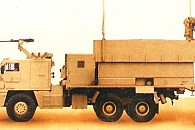Artillery / Multiple rocket launchers / ASTROS II
ASTROS II
General Facts
- TYPE
Multiple rocket launcher - ORIGIN
 Brazil
Brazil - NICKNAMES
Sajeel 60 (Iraqi designation) - DESIGNED
Early 1980's - DESIGNER
Avibrás - PRODUCTION
Early 1980's - late 1990's, but still available - PRODUCERS
 Brazil - Avibrás
Brazil - Avibrás - QUANTITY
At least 168 - UNIT COST
Unknown - CHARACTERISTICS
 Interchangable rocket types
Interchangable rocket types
 Accurate and long range
Accurate and long range
 Good level of protection
Good level of protection
 Good mobility
Good mobility
Introduction
The ASTROS II is a multiple rocket launcher of Brazilian origin. It was developed in the early 1980's by Avibrás for Brazilian and export use. The ASTROS II design is unique as it was the first system to offer multiple types of artillery rockets from the same launch system. The name ASTROS is short for Artillery SaTuration Rocket System.
Layout
The ASTROS II is based on the TECTRAN family of armored 10 t trucks. The launch vehicle has a launch installation on the flatbed which is reloaded with four boxes that may feature various kinds of rocket types. Four jacks stabilize the vehicle in the launch position. The target coordinates are relayed from the command vehicle and the fire mission is carried out from within the vehicle.
Firepower
The ASTROS II launch vehicle may carry 32 127mm rockers, 16 180mm rockets and 4 300mm rockets. The maximum range of the 127mm rockets is 30 km while the longest range 300mm rocket may reach up to 90 km. The small 127mm rockets have a unitary warhead while all other models feature 20 to 65 dual purpose anti-personnel and anti-tank bomblets. A 12.7mm M2HB heavy machine gun is mounted on the roof for self-defense.
Protection
The TECTRAN trucks feature an armored cab that protects the crew from small arms fire and shell splinters. The vehicle is operated from under armor protection. Six smoke grenade launchers are fitted on the roof ring mount. The presence of a NBC system is likely. The ability to shoot and move away quickly reduces the risk of counter battery fire.
Mobility
The ASTROS II is a highly mobile system with high speeds on road and the 6x6 chassis provides a good cross country performance. A Mercedes 280 hp diesel engine provides propulsion.
Users
The first user of the ASTROS II was Brazil. The majority of the ASTROS II systems were exported, mainly to the Middle East. The ASTROS II was extensively used by Iraq during the Iran-Iraq war and by Iraq and Saudi Arabia during the 1991 Gulf War. The ASTROS II remains available for production.
ASTROS vehicles
The ASTROS II system consists of several vehicles which are all based on the TECTRAN VBT-2028 6x6 10 t truck chassis. Usually a battery consists of 6 launchers, 6 transloaders and a radar vehicle. Other variations include 4 launchers, 2 transloaders and a radar vehicle.
AV-LMU: The AV-LMU is the launch vehicle that carries and launches all types of ASTROS rockets. The launch vehicle may carry 32 SS-30, 16 SS-40 or 4 SS-60 and SS-80 missiles.
AV-RMD: The AV-RMD is a transloader that carries two full loads for the AV-LMU on its flatbed and uses a hydraulic crane for reloading.
AV-UCF: The AV-UCF is a radar fire control vehicle which may be used to track and adjust the ASTROS rockets and identify enemy launch positions. The radar system used is the Contraves Fieldguard system.
AV-VCC: The AV-VCC is a command and control vehicle with a shelter body. It can be used to command several batteries.
AV-MET: The AV-MET is a mobile weather station that provides atmospheric data to improve the targeting process.
AV-VBA: The AV-VBA is the maintainance vehicle of the ASTROS system. As with the AV-VCC it is not present in every battery.
AV-CBO: The AV-CBO is a radar vehicle to search for ships and provide targeting data for the ASTROS in the anti-shipping role. Only Brazil uses this vehicle.
- Specifications:
- AV-LMU
| Type | Multiple rocket launcher |
|---|---|
| Crew | 3 |
| Length | 7 m |
| Width | 2.9 m |
| Height | 2.6 m |
| Ground clearance | ? |
| Weight | 20 t combat load |
| Ground pressure | ? |
| Wheelbase | Wheeled chassis, 6x6 |
| Turn radius | ? |
| Engine | Mercedes OM442 8-cylinder diesel, 280 hp |
| Power ratio | 14.0 hp/t |
|---|---|
| Transmission | ? |
| Speed | 90 km/h on road, 35 km/h cross country |
| Fuel | 250 L |
| Range | 480 km |
| Wall | 1 m |
| Trench | 2.3 m |
| Gradient | 60% gradient, 20% slope |
| Fording | 1.1 m |
| Armor | ? |
| NBC equipment | ? |
| Night vision | ? |
|---|---|
| Smoke | 6x smoke grenade launcher |
| Remarks | - |
| Armament | ASTROS rocket launcher 12.7mm M2HB heavy machine gun |
| Weapon1 | ASTROS launcher on flatbed 4 reloading boxes with 1 to 8 rockets each, all ready to fire |
| Weapon2 | 12.7mm M2HB heavy machine gun on roof 100 rounds ready to fire manual traverse and elevation non-stabilized |
| Weapon3 | - |
| Weapon4 | - |
| Weapon5 | - |
| Weapon6 | - |
ASTROS rockets
The ASTROS II system is able to use four kinds of spin stabilized artillery rockets. The rockets are carried in long square reloading boxes of which four are carried on the launch vehicle and eight on the transloader. The rockets have the same sleek design with wrap around folding rear fins and only differ in size. The available warheads include high explosive, incendiary white phosfor, concrete piercing, mixed bomblets, AP and AT mines.
127mm SS-30: The SS-30 is the smallest ASTROS artillery rocket and due to its size it has a unitary warhead. Eight rockets are fitted in a single reloading box.
180mm SS-40: The SS-40 is the medium size ASTROS rocket. It is the smallest rocket in the system to feature a warhead with bomblets. Four rockets are fitted in a reloading box.
300mm SS-60: The SS-60 is the standard long range artillery rocket. A single missile is loaded in a launch box. A single rocket is carried in a reloading box.
300mm SS-80: The SS-80 is the extended range version of the SS-60 and has the same dimensions. The warhead size is reduced to carry more rocket fuel.
| Type | Artillery rocket |
|---|---|
| Diameter | 127 mm body |
| Length | 3.9 m |
| Weight | 68 kg |
| Guidance | Unguided, ballistic flight |
|---|---|
| Warhead | 25 kg unitary warhead |
| Propulsion | Solid fuel rocket motor |
| Speed | 2.400 km/h |
| Range | 9 km minimum, 30 km maximum |
|---|---|
| Altitude | - |
| Engagement envelope | - |
| Remarks | - |
| Type | Artillery rocket |
|---|---|
| Diameter | 180 mm body |
| Length | 4.2 m |
| Weight | 152 kg |
| Guidance | Unguided, ballistic flight |
|---|---|
| Warhead | 45 kg warhead, 20 dual effect bomblets |
| Propulsion | Solid fuel rocket motor |
| Speed | 2.400 km/h |
| Range | 15 km minimum, 35 km maximum |
|---|---|
| Altitude | - |
| Engagement envelope | - |
| Remarks | - |
| Type | Artillery rocket |
|---|---|
| Diameter | 300 mm body |
| Length | 5.6 m |
| Weight | 595 kg |
| Guidance | Unguided, ballistic flight |
|---|---|
| Warhead | 212 kg warhead, 65 dual effect bomblets |
| Propulsion | Solid fuel rocket motor |
| Speed | 2.100 km/h |
| Range | 20 km minimum, 60 km maximum |
|---|---|
| Altitude | - |
| Engagement envelope | - |
| Remarks | - |
| Type | Artillery rocket |
|---|---|
| Diameter | 300 mm body |
| Length | 5.6 m |
| Weight | 595 kg |
| Guidance | Unguided, ballistic flight |
|---|---|
| Warhead | 180 kg warhead, about 55 dual effect bomblets |
| Propulsion | Solid fuel rocket motor |
| Speed | 2.100 km/h |
| Range | 22 km minimum, 90 km maximum |
|---|---|
| Altitude | - |
| Engagement envelope | - |
| Remarks | - |








